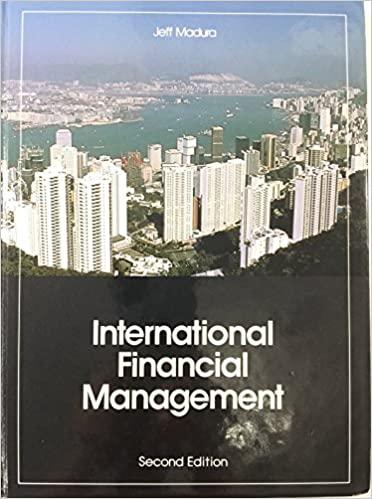Corporate Finance Questions:
We were not provided a model answers/answers in general for these mocks. Would someone please explain each one please? I've attempted some of the maths based ones, but unsure if it's correct due to no answers being provided. Thanks! For question one, is it a) False --> Only links with reducing risks b) False? --> Caused by conflicts of interests amongst stakeholders?


1. Answer the following questions. a) Indicate true or false to the following statements (no explanations needed): i) Diversification is a sensible reason for mergers because it is cheaper for corporations to diversify their business portfolios than for investors to diversify their portfolios. the senior management's inability to control ii) Agency costs arise from shareholders. [5 marks each; 10 marks] b) Suppose the total value of the firm is 150 million. The firm's debt-equity ratio is 0.5, and the interest rate (before tax) on its debt is 4 percent, while its cost of equity is 12 percent. The effective corporate tax rate is 25 percent. By assuming that the Modigliani-Miller Theorem with corporate taxes holds, answer the following questions. i) What is the value of equity of the firm? ii) What is the after-tax WACC (weighted average cost of capital) of the firm? [5 marks each; 10 marks] c) A firm has the following capital structure: 100 million shares outstanding, trading at 1.5 per share, and 100 million of debt. The beta of the firm's stock is 1.5. The firm's cost of equity is 10 percent, and the yield on riskless bonds is 2.5 percent. There is no tax. Assuming that the firm can borrow at the risk free rate and that both CAPM (Capital Asset Pricing Model) and the Modigliani-Miller theorem hold, answer the following questions. i) What is the total value of the firm? ii) What is the WACC of the firm? iii) What should be the expected return on the market portfolio? iv) Suppose the firm changes its capital structure so that its debt increases to 150 million, and the equity decreases by 50 million. What should be the firm's cost of equity after the change? [5 marks each; 20 marks] 3. Suppose a large institutional investor Alliance's portfolio has a beta of 0.5. Another institutional investor Best's portfolio has an expected return of 10 percent and a standard deviation of 15 percent. Both portfolios have the same Sharpe ratio of 0.6, and the market portfolio can be described as a portfolio comprising these two with equal weights. Suppose there is a firm called Cunning corporation, whose stock's beta is 2 and it can borrow at the risk free rate. Cunning's equity value is 1 million and its debt is 1.5 million. The present value of Cunning's tax shield is 0.3 million. Assuming that both CAPM and the Modigliani-Miller theorem with corporate taxes hold, answer the following questions. a) What is the risk free rate? [5 marks] b) What is the expected return on the market portfolio? [5 marks] c) What is the after-tax WACC of Cunning? (10 marks] [Total 20 marks] 1. Answer the following questions. a) Indicate true or false to the following statements (no explanations needed): i) Diversification is a sensible reason for mergers because it is cheaper for corporations to diversify their business portfolios than for investors to diversify their portfolios. the senior management's inability to control ii) Agency costs arise from shareholders. [5 marks each; 10 marks] b) Suppose the total value of the firm is 150 million. The firm's debt-equity ratio is 0.5, and the interest rate (before tax) on its debt is 4 percent, while its cost of equity is 12 percent. The effective corporate tax rate is 25 percent. By assuming that the Modigliani-Miller Theorem with corporate taxes holds, answer the following questions. i) What is the value of equity of the firm? ii) What is the after-tax WACC (weighted average cost of capital) of the firm? [5 marks each; 10 marks] c) A firm has the following capital structure: 100 million shares outstanding, trading at 1.5 per share, and 100 million of debt. The beta of the firm's stock is 1.5. The firm's cost of equity is 10 percent, and the yield on riskless bonds is 2.5 percent. There is no tax. Assuming that the firm can borrow at the risk free rate and that both CAPM (Capital Asset Pricing Model) and the Modigliani-Miller theorem hold, answer the following questions. i) What is the total value of the firm? ii) What is the WACC of the firm? iii) What should be the expected return on the market portfolio? iv) Suppose the firm changes its capital structure so that its debt increases to 150 million, and the equity decreases by 50 million. What should be the firm's cost of equity after the change? [5 marks each; 20 marks] 3. Suppose a large institutional investor Alliance's portfolio has a beta of 0.5. Another institutional investor Best's portfolio has an expected return of 10 percent and a standard deviation of 15 percent. Both portfolios have the same Sharpe ratio of 0.6, and the market portfolio can be described as a portfolio comprising these two with equal weights. Suppose there is a firm called Cunning corporation, whose stock's beta is 2 and it can borrow at the risk free rate. Cunning's equity value is 1 million and its debt is 1.5 million. The present value of Cunning's tax shield is 0.3 million. Assuming that both CAPM and the Modigliani-Miller theorem with corporate taxes hold, answer the following questions. a) What is the risk free rate? [5 marks] b) What is the expected return on the market portfolio? [5 marks] c) What is the after-tax WACC of Cunning? (10 marks] [Total 20 marks]








